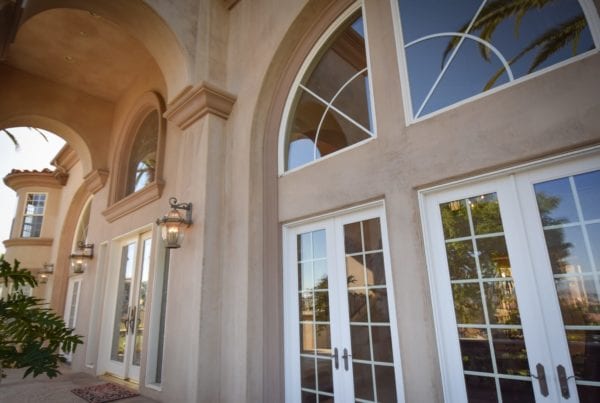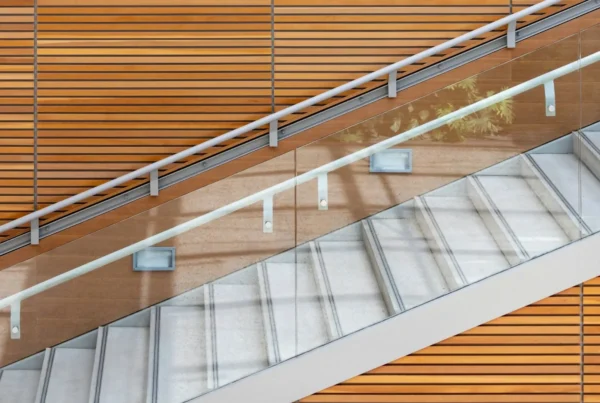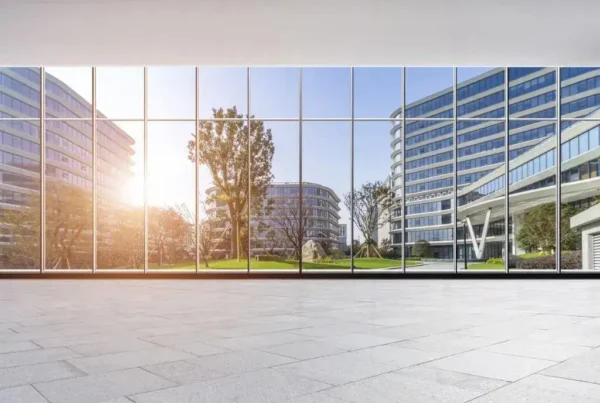Frosted glass is any type of glass that’s been made to have a translucent or nearly opaque, frost-like appearance.
Different types of frosted glass can be used for a variety of commercial glazing applications in order to enhance aesthetics and/or add privacy to glass doors and windows.
Frosted glass can also be used to limit the amount of light that filters through windows and reduce glare without blocking the transmission of light completely.
What Types of Frosted Glass Are There?
Commercial frosted glass is typically made in one of two ways: sandblasting or acid etching.
But there’s a third, more cost-effective way to turn any existing glass into frosted glass: adding certain types of frosted window film to the glass.
Sandblasted frosted glass
Sandblasted glass is any glass that has been blasted with sand or other abrasive materials using high-pressured air.
This sandblasting process changes the finish of the glass, roughing it up and giving it a frosty, translucent appearance.
Changing the speed and pressure of the sandblasting machine achieves different levels of translucency in the glass.
Sandblasting can be done either to an entire glass surface or to specific areas to create unique patterns or designs in the glass.
Acid-etched frosted glass
Acid-etched glass is made by applying hydrofluoric acid to the surface of regular glass. The acid corrodes the surface and gives it a milky, frosted appearance.
As with sandblasting, the acid can be applied to a whole sheet of glass or only to certain areas to make some parts frosted and leave others transparent.
Depending on how much acid is applied to the glass, it’s possible to make it anywhere from about 10% to 100% opaque.
After the acid etching process, the glass is washed thoroughly to remove any traces of the hazardous acid, and the frosted glass is then ready for use.
Frosted window film
Applying frosted window films to glass doors and windows is a popular alternative to installing sandblasted frosted glass or acid-etched frosted glass because it can be done to any existing glass surfaces.
In other words, you can easily apply a fully frosted finish or various frosted designs to glazing that’s already installed and in use.
Window films consist of unique formulations of poly-based plastics that allow them to look and perform in various ways.
Frosted window film is a type of decorative window film that gives the glass it is applied to the same type of translucent or opaque appearance as other types of frosted glass.
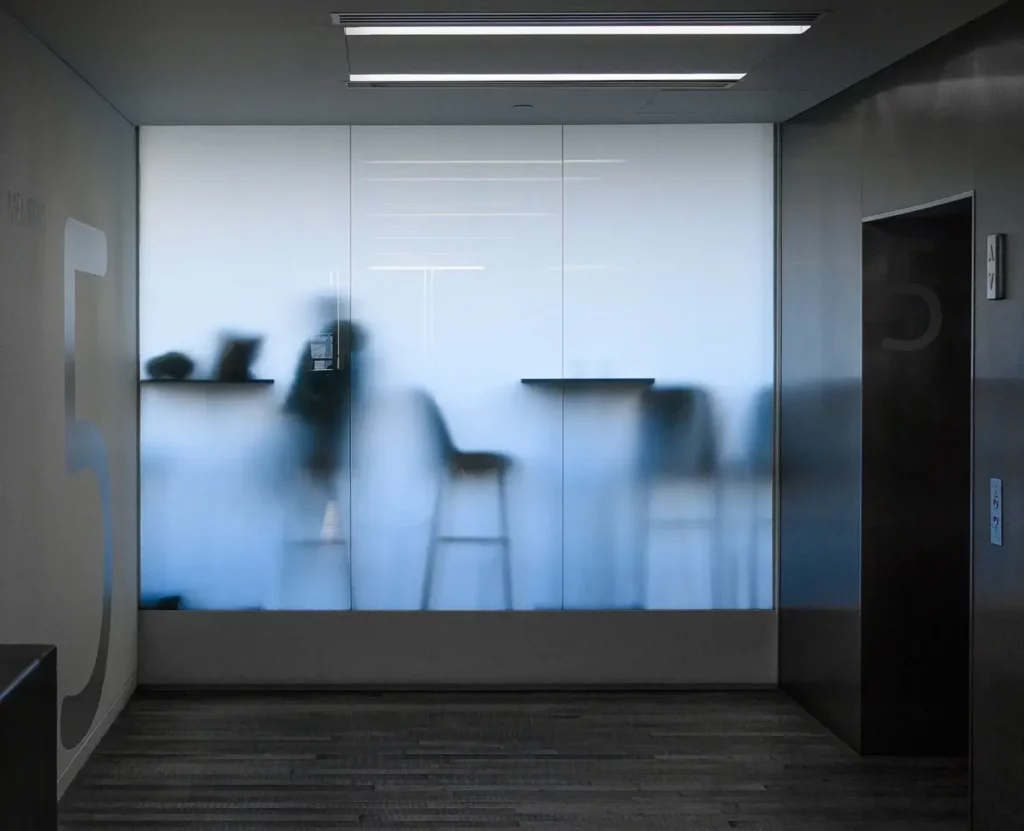
Since window film can be applied to most existing glass surfaces, there’s no need to replace window or door glass with sandblasted or acid-etched frosted glass to get the appearance, functionality, or level of privacy you want.
What’s The Best Type of Frosted Glass?
Although the end result of using any of the different glass frosting methods discussed above is very similar, there are some pros and cons of each type of frosted glass to consider.
Pros and cons of sandblasted frosted glass:
- Pro: designs can be made by masking off areas of the glass before sandblasting
- Pro: easy to create different levels of opacity, including gradients in one piece of glass
- Pro: readily available with lots of different designs
- Con: hard to keep clean (collects fingerprints and smudges)
- Con: expensive
Pros and cons of acid-etched frosted glass:
- Pro: low-maintenance (less likely to get fingerprints and other marks on it)
- Pro: offers more variation in terms of degree of transparency
- Pro: more realistic frosted appearance
- Con: acid etching process is hazardous (harder to find local producers)
- Con: more expensive than sandblasted glass
Pros and cons of frosted window film:
- Pro: can be applied to almost any existing glass surface
- Pro: wide range of finishes available
- Pro: can be printed and cut to create any designs or logos you want
- Pro: very affordable
- Con: wears out eventually (but often lasts 20+ years)
If you have the time and budget for it, acid-etched or sandblasted frosted glass are attractive options.
But, if you don’t want to undergo a time consuming and costly commercial glass replacement project, we highly recommend using decorative frosted window film to achieve the results you want — at a fraction of the cost and in a fraction of the time.
Plus, another pro of using frosted window film that we didn’t mention above is that it can be inexpensively removed and replaced if your aesthetic preferences or privacy needs change.
Where Can You Use Different Types of Frosted Glass?
There are many different ways you can use frosted glass, including frosted window films, in commercial architectural applications. It’s ideal for improving aesthetics (decoration), adding privacy, and controlling light transmission.
Decorative frosted glass
Decorative frosted glass with patterns, such as dots, lines, and more intricate patterns, can give any space more aesthetic appeal. It can also be used to add things like logos or other branding elements to windows and doors.
Frosted glass for privacy
Frosted glass can be used to add privacy to certain buildings or rooms within facilities without completely blacking out the windows.
For instance, you might apply frosted window film to glass conference rooms or glass office windows to provide more privacy for meetings and other work activities. Frosted windows are also ideal for bathrooms.
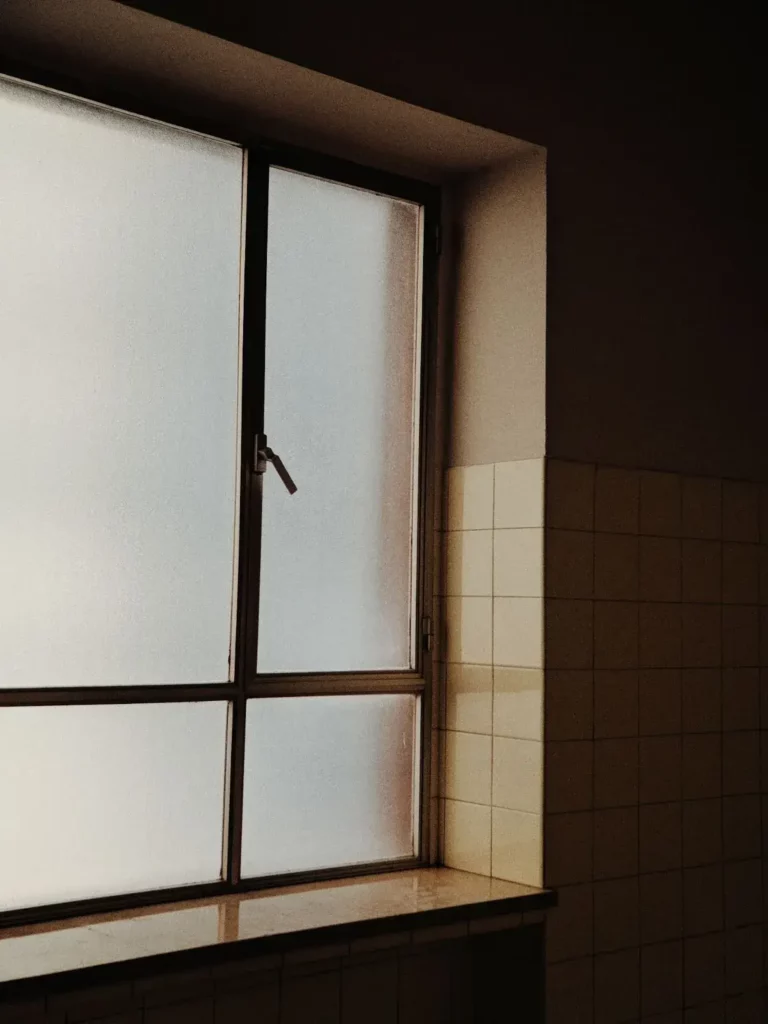
Frosted glass for controlling light transmission
Another benefit of frosting commercial building windows is that it allows you to reduce the amount of glaring light coming through windows and doors as an alternative to closing curtains, blinds, or drapes.
Frosted windows refract the direct sun beams, scattering the light around the room which helps add light to darker corners and breaks up the blinding glare of a direct sun beam, so it’s more comfortable to work on the other side.
Final Thoughts on Commercial Frosted Glass Doors and Windows
More often than not, commercial building owners and occupants want to frost windows for some combination of all the benefits mentioned above.
Frosting glass office or reception area windows, for example, adds privacy where needed, while still allowing some amount of natural light in.
Whatever your reasons for wanting to install frosted glass are, we highly recommend using frosted window film, as it’s the most cost-effective and fastest method for frosting existing windows and doors.
Contact us today and ask how we can help!

